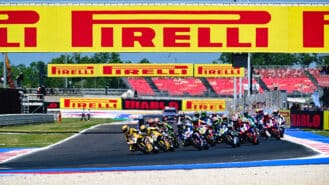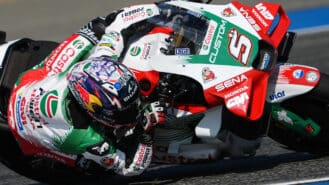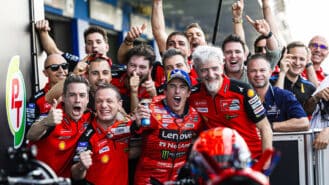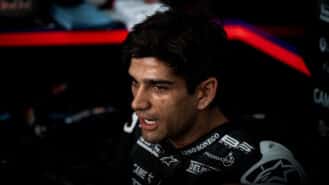Michelin may surpass Bridgestone, but not for long because Dorna’s long-term plan is to reduce MotoGP corner speeds

At Valencia last week Michelin more or less matched Bridgestone’s lap times, albeit at the cost of a pile of trashed carbon-fibre and scuffed leathers.
Making exact comparisons between lap times with the French tyres and the Japanese tyres is fruitless, because most riders were also testing Dorna’s compulsory software.
In brief, Marc Marquez was the fastest man on Michelins, four tenths quicker than his best race lap, but half a second off his qualifying best. Maverick Vinales was the best improver: second fastest in the tests, 1.6 seconds better than in the race and two tenths quicker than in qualifying. Yamaha riders Jorge Lorenzo and Valentino Rossi struggled most, both slower than their race pace.

The stopwatch numbers made the Michelin men happy, the complaints they received from riders about lack of front feel (the main cause of the many accidents) less so.
What Michelin may or may not know is that they have only a year or two to show what they can do – to make Marquez and the rest go faster than ever before – before Dorna put the brakes on. Dorna’s long-term desire is to reduce corner speeds. Not because they think that 65 degrees of lean angle is too much but because riders are running out of room to crash.
Very soon the fastest tracks – Phillip Island, Mugello and Brno – won’t have enough runoff. Bikes are hitting barriers, sometimes riders too. Most famously, Rossi’s Yamaha vaulted the Armco at Brno a couple of years ago, narrowly missing a BMW car chauffeuring VIPs around the track access road. That’s what you call a VIP experience.
There are two solutions to this problem. You either take Mugello and those other tracks off the calendar, because topography and costs make it prohibitive to continually expand gravel traps, or you reduce corner speeds.
It’s a no-brainer, to me at least. MotoGP’s fastest tracks are the best. They produce the best action and the best racing. Look at Valencia, a typically modern ‘intestinal’ racetrack that winds its way around itself, leaving nowhere to overtake (never mind the conspiracy theorists of recent weeks).
Dorna’s Director of Technology Corrado Cecchinelli has a favoured solution: to reduce wheel rim sizes to reduce contact patch, grip and therefore corner speeds. Compared to changing bore and stroke or rewriting rider-aid software, it’s a breeze.
This, of course, is in the future, but what about now? The switch of control-tyre brands is already making MotoGP look different. At Valencia last week riders were visibly slower into corners but were they having a lot more fun on the exits. None more so than Jack Miller who rode his Honda RC213V like a dirt bike, suggesting the Michelin rear has more feel than the Bridgestone rear.
Some riders will gel better with the French rubber than others – some winners will becomes losers and vice versa. It has always been thus. A change of tyres can be a bigger problem for riders than a change of bike.

James Toseland’s MotoGP career turned to dust in 2009 when he switched from Michelin to Bridgestone and suffered a terrifying high-speed highside during preseason tests. In 1998 Simon Crafar (below) won the British 500 GP and nearly beat Mick Doohan at Phillip Island while using Dunlops. He changed to Michelins for 1999, struggled to get inside the top ten and lost his ride midway through the season.
Crafar’s story is particular interesting in the light of Michelin’s front-tyre issues. The New Zealander revelled in Dunlop’s front slick because he could take advantage of the tyre’s strange behaviour entering corners. Going into a corner the load on the front tyre increases, flattening the rubber against the road and expanding the contact patch. When the rider gets off the brakes and on the throttle the load transfers towards the rear, so the front tyre returns to its normal profile. Crafar somehow managed to harness this ‘bounce’ moment (as the Dunlop reformed to its usual shape) to help him turn the corner. Safe to say, not many riders could do that.

The 2016 Motor Sport Hall of Fame: Vote for Mick Doohan, Geoff Duke, Joey Dunlop, Mike Hailwood, Eddie Lawson, Wayne Rainey, Kenny Roberts, Valentino Rossi, Kevin Schwantz, Barry Sheene, Freddie Spencer or Casey Stoner
At Valencia some MotoGP riders complained that the front Michelin’s contact patch didn’t stay constant for long enough. It went big, small, big, small as they rode through corners, so the riders didn’t know where they were, which no doubt explains the lack of feel and the number of crashes.
Bridgestone’s front and rear slicks had stiffer sidewalls which gave riders what they called a platform – a consistent contact patch – with which to work. Unlike the Michelin front, Bridgestone’s front was pretty much impossible to overload. So, surely, all Michelin need do is build stiffer sidewalls.
If only it were that easy. At Valencia Rossi wondered if the Michelin front will ever change much.
“The front [carcass] is a bit softer than the Bridgestone – this is the DNA of the tyre and I think it will remain always,” he said. “The rear has very good grip and very good traction in acceleration. The front is the big difference, so we need to understand how much load this tyre needs to turn the bike at the maximum. The tyres are a great, great difference for next year; it will be interesting for sure.”
Rossi likens the feel of the current Michelin front to the feel of the company’s front slick in 2007, when he last used the French tyres. That was the year Casey Stoner stormed to Bridgestone’s first MotoGP title. The previous year Stoner had spent his rookie season losing the front on his Michelin-equipped Honda RC211V and scratching his head in bewilderment.


No one is perfect though. Bridgestone had a terrible few years as control tyre supplier – from 2010 to 2012 – when their rear tyres were too slow to heat up and too quick to cool down. Those tyres had a horrible habit of tossing riders over the highside – most famously Rossi at Mugello in 2010 – and there’s no racer in the world who would choose a rear-end highside over a front-end low-side.
At the Valencia tests it looked like the Michelins helped the Honda more, offering the rear grip the RC213V sometimes lacks, while hampering Yamaha’s huge, arcing corner entries. But, like I said, take no notice. Nothing matters until the sun sets in Qatar on 20th March.










